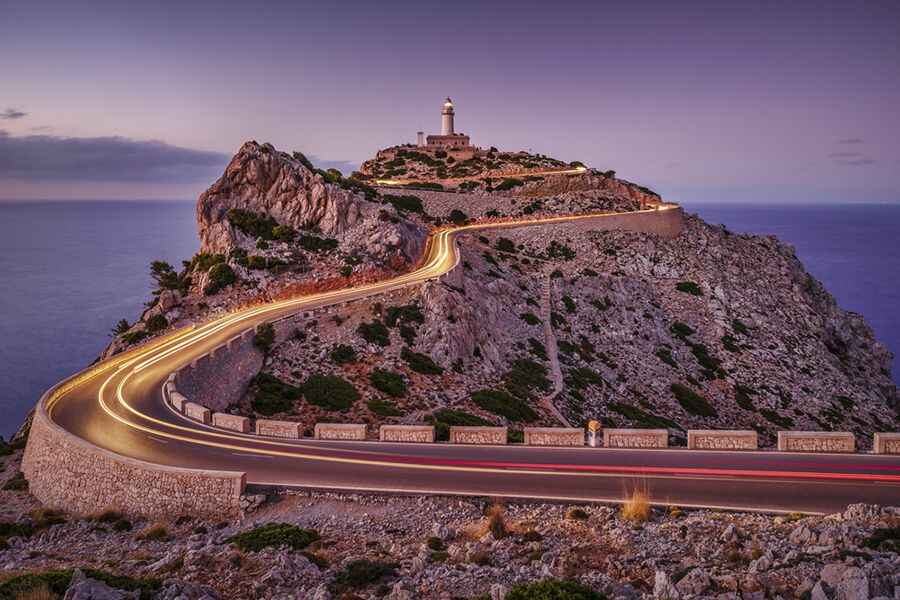The sensational road to Formentor Lighthouse in Mallorca
Far de Formentor is a spectacular lighthouse built in 1863, at an elevation of 119m (390ft) above sea level, located at the eastern end of Mallorca's Formentor peninsula, in Spain. It’s one of the best roads in Mallorca.

Can I drive to Formentor Lighthouse?
Tucked away on the northernmost point of the Balearic Island of Mallorca, the road to the lighthouse, also known as Cap de Formentor Lighthouse, is stunning. It’s called MA2210. It’s totally paved. Starting at Platja de Formentor, the road is 10.9 km (6.77 miles) long. The lighthouse, a true feat of construction given the steep terrain, hosts a bar and a shop.
Is the road to Formentor Lighthouse difficult?
Due to its narrowness and drop-offs over the sea, the road can be pretty scary. The route is hilly and includes 1,600m (5,200ft) of climbing. The gradients are relatively sedate, usually around 7-8%, although there are short sections of 10%+. As is usual for mountain roads, when the slope was too steep, the road has to go oblique, and switch direction when needed. The drive is not for the faint of heart. In fact, it can be scary. The road winds in and around plunging limestone cliffs, where drop-offs are literally jaw-dropping. Someone with vertigo should not be driving.
Is the road to Formentor Lighthouse open?
Set high at the northern edge of the Sierra de Tramontana, in the summer of 2018, the local government reached an agreement to disallow access for private cars, including rented cars, to the lighthouse. Access is only by walking, cycling, or taking a public shuttle bus from the new transit station down in Port de Pollença. Due to traffic jams, the road is not accessible by car from 10 am to 7 pm in the high season (between June 15th and September 15th). During this period, the road is accessible only to buses; cars need to be parked. The reason for this limited access is to avoid chaotic situations and traffic jams on the narrow mountain road. Before the current traffic restrictions, and especially during high season, the road was extremely crowded, with cars waiting in line to move forward. The volume of visitors to the peninsula increases dramatically during the summer months, far exceeding the capacities of the narrow and winding mountain road that leads all the way up to Cap de Formentor.
Where was the Seat Cupra advert filmed?
The road to the lighthouse has become a real magnet for filming movies and ads. Countless TV advertisements have been shot on the road to the lighthouse. It has a privileged location far away from the main tourist hotspots in Majorca, which has inspired numerous artists to write poems and create paintings.
Is the road to Formentor Lighthouse really worth it?
Located in one of the island's most rugged and isolated places, driving the road without stopping will take most people between 20 and 30 minutes. However, due to its beauty, the drive will take longer. There are a few viewpoints along the way, so make sure to reserve some extra time. This is an enjoyable drive along a serpentine road. The drive offers stunning views of the rugged Mallorcan coast. It’s said to be one of the most scenic drives in the world. The drive has scenery as dramatic as anyone could wish for. Cliffs 400 meters tall jut into the sea, their weird rock formations attracting nesting seabirds, while pine trees seem to grow out of the rocks. Currently, it is the lighthouse with the focal plane at the highest altitude in all the Balearic Islands. Obviously, from this spot, an awesome view of the most northern part of the North Range can be observed.
When was the road to Cap de Formentor Lighthouse built?
The road was built by the Spanish engineer Antonio Parietti in 1925. His masterpiece on Mallorca, however, was the snake road to Sa Calobra. Instead of being overwhelmed by what stood in his way on the cliffs, Parietti observed the Tramuntana winds and understood: where the slope was too steep, he made a curve. When he had to remove part of the cliffs, he placed the waste in other places where it was needed. The result was the two roads, which are nestled together in the mountains like abandoned silk ribbons. The lighthouse opened in 1863 as part of the coastal lighting scheme to provide greater safety for boats sailing off Mallorcan shores at night.
Image credit: Depositphotos